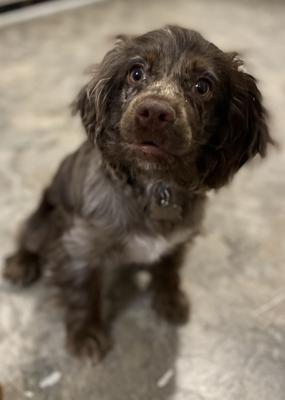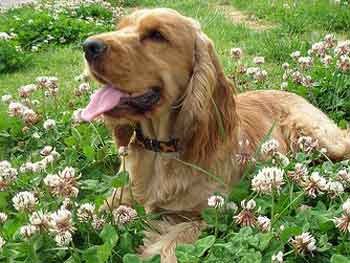- Home
- Grooming a Cocker Spaniel
- Caring for Cocker Spaniel ears
Caring for Cocker Spaniel Ears To Help Keep Your Dog's Ears in the Pink!
Cocker Spaniel ears are beautiful, but they are prone to health problems, especially if you don't give them some attention from time to time.
Learn how to care for your Cocker's ears, spot the early signs of infection, and keep them clean, healthy, and problem-free.
Caring for Your Cocker Spaniel's Ears
Cocker Spaniel ears are luxuriously long and pendulous and soft and silky to the touch. I never tire of brushing and stroking them.
Unfortunately, such beauty comes at a price!
Cocker Spaniel ears need extra care and attention to keep them healthy and free from infection.
Here are some helpful tips and advice on keeping your Cocker Spaniel's ears in the pink!
Checking Cocker Spaniel Ears
Ear Problems in Dogs: Knowing What To Look For...
Cocker ears may be prone to infection, but checking them often, making sure they're clean, and brushing them will go a long way to eliminate bacteria, disease, and other ear problems.
Checking your dog's ears for early signs of infection(s) only takes a minute, so you should be able to do this every day.
Lift your pet's ear and look at the condition of the skin. Does it look a lovely healthy pink, or is it red and inflamed?
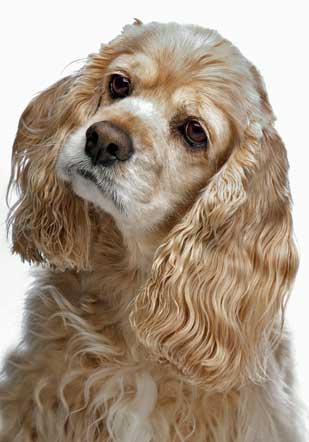 Cocker Spaniel ears are beautiful!
Cocker Spaniel ears are beautiful!It shouldn't smell, and there shouldn't be any discharge; a pleasant clean 'doggie' smell is what we want.
A small amount of wax is expected, so it's not usually something you need to worry about; it can easily be removed when cleaning your Cocker Spaniel's ears.
If the inside of his ear is red or looks inflamed, or if there's a large amount of wax, especially if it smells unpleasant (like cheesy feet) or is very dark in colour, then your dog may have an ear infection.
It's probably time to visit the vet.
Checking Cocker Spaniel Ears For Grass Seeds
It's essential to check your Cocker's ears for grass seeds or twigs after his walk, especially if he's lucky enough to have open fields to run through.
Although it's good for him to run free like that from time to time (my dog loves it!), there's always a downside.
Most of the year, there's always something bursting into bloom or seed, whether it's grass seeds, burs, or other 'sticky' vegetation, and they just love Cocker Spaniel ears!
If you don't remove plant debris from your Cocker's coat, a stray seed could quickly work inside your pet's ear or skin, causing considerable pain and eventual infection.
How To Know That Your Dog Has Something In His Ear
You can quickly tell if your dog has something in his ear.
He may shake his head from side to side (more than usual) or stand still and tilt his head to one side as though he's listening to something.
Frantic scratching is another tell-tale sign of dog ear problems, and he may also yelp or show other signs of pain if you try to rub or touch his ears.
If you suspect your Cocker has something stuck in his ear, you should leave it and ask your vet to remove it unless you can see it without 'digging' into your dog's ear.
Improving Ventilation in Cocker Spaniel Ears
By design, Cocker Spaniel ears hang low and cover the opening to the ear, which means that their inner ears don't get enough air circulating to keep them as healthy as possible.
There's usually quite a lot of hair on the underside of their ears, especially around the ear opening, which can also contribute to poor air circulation.
This lack of ventilation can create a dark, warm, moist habitat - ideal breeding conditions for bacteria...and that's when the trouble begins!
Let's see what we can do to make Cocker Spaniel ears less of a breeding ground for bacteria.
Removing Excess Inner Ear Hair
You can help improve air circulation in and around Cocker Spaniel ears by removing excess hair from just inside the ear opening.
Simply grip a few strands between your thumb and index finger and pull gently to remove this hair.
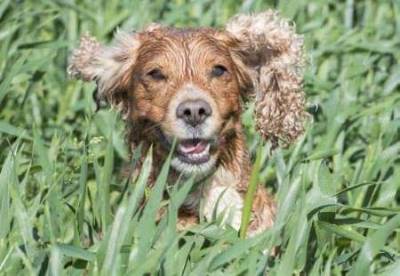 It's so easy for Cocker ears to pick up grass seeds while running in fields
It's so easy for Cocker ears to pick up grass seeds while running in fieldsIf you prefer, you could use tweezers or a haemostat.
Be sure to remove only a few hairs at a time and always pull in the same direction that the hair is growing.
Be careful not to work any further into your dog's ear than about half an inch (12.5 mm), as this area can be quite sensitive and easily damaged.
To better grip the hair, you can spray your pet's ear with a bit of medicated powder (or baby powder) to help absorb any moisture and wax and stop the hair from slipping through your fingers.
If you don't feel too confident about removing hair from inside your pet's ears, don't worry, your dog groomer will be able to do it for you or, at the very least, show you how to do it yourself.
Trimming Cocker Spaniel Ears
The hair underneath your dog's ear canal opening can grow quite thick and can often clump into mats unless it's brushed every day.
I usually trim this area into a neat semi-circle, but I sometimes cut it back fairly close to the skin.
Both methods will help to improve air circulation and will be much easier to brush too!
Some breeders and groomers also recommend shaving the underside of Cocker Spaniel ears (the leathers) to help keep them fresh. Whilst this works, I don't think it's always necessary. It's what I do for Max, but it's a personal choice, as with most things.
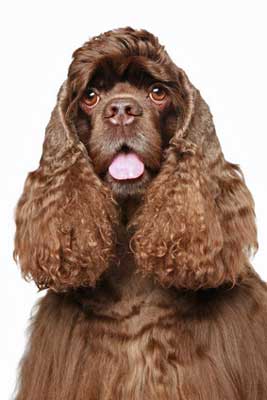 Beautifully kept Cocker Spaniel ears!
Beautifully kept Cocker Spaniel ears!Keeping your Cocker's ears neatly trimmed and brushed will help get the air circulating around the ear canal and help keep his ears cool and dry - lessening the chances of bacteria over-breeding.
Cocker Spaniel Ears: Keep The Air Flowing!
If your Cocker is a regular sufferer of ear infection or his condition is chronic, you can do a couple of things to help to get the air circulation in and around his ears.
- Lift your Cocker's ears above his head (to expose his ear canals) and tie them gently together with a scrunchy to let the air get at them for a couple of hours each day. I can't guarantee how long they'll stay up, though!
- If your dog tries to remove them, which he probably will, you can also use a stretchy tubular bandage (not the sticky sort, mind you). Just be careful that it doesn't slip over his eyes.
Simply slip it over your Cocker's muzzle, over the top of his head and a little way down the back of his neck. It might look a little odd, but it will do the trick! Make sure the holes are lined up with his open ears so that it exposes them to the air.
PS: In chronic cases, I'm assuming your dog has been to see the vet and that he's given you medication or treatment for any infection.
Letting the air to your dog's ears certainly won't cure an infection, but it will help to keep the ears dry and prevent bacteria from growing in the first place.
Summary: Caring for Cocker Spaniel Ears
Whilst I recommend you watch for early signs of ear infection, it's essential to get an accurate diagnosis and the correct treatment from your vet as soon as you can.
It's not always straightforward identifying ear infections in dogs, so the vet may have to try several treatments before he's successful, which can be very expensive.
Infections can be excruciating for your pet, and if left untreated, there may be a risk of permanent damage.
Doesn't it make much more sense to be proactive by avoiding ear infections and other dog ear problems in the first place?
Photo credits: Cocker Spaniel Ears
1. Erik Lam at Dreamstime.com - httpswww.dreamstime.comaccountdownloads-index
2. Andrea Izzotti at Fotolia.com - https://stock.adobe.com/fr/52492516
3. Jagodka at Fotolia.com - https://stock.adobe.com/fr/33327271

